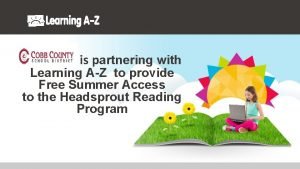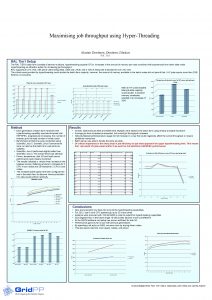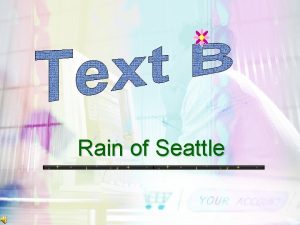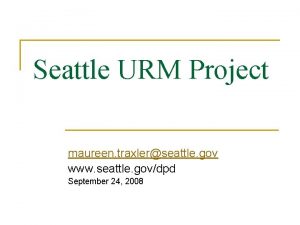Seattle Washington Can the Headsprout Program Improve Reading























- Slides: 23

Seattle Washington

Can the Headsprout Program Improve Reading Skills in a Preschool Classroom? By Tracy Newton Cadeau

Subjects • All subjects were four years old • All were Head Start eligible (income) • All subjects lived in the same geographic location • All subjects were in a preschool classroom

Treatment Group Control Group A. M. Classroom P. M. Classroom • A traditional preschool experience • Ten to twenty minutes using the Headsprout Early Reading program • Ten to twenty minutes additional conventional activities • Seven girls and eight boys • Seven girls and nine boys

Equipment • • • Six e. Mac computers with internet access Individual headsets Mouse Headsprout Early Reading program Low standing eight foot table with chairs Partitions between each computer and behind • Timer

Assessments Individual Growth and Development Indicators (IGDIs) One minute reading • Four times • One time 10/26/09 1/6/10 3/10/10 5/10/10 Two months after semester ended

Assessment (Continued) Establishing a baseline IGDI assesses in three domains 1. Picture Naming 2. Rhyming words 3. Alliteration

Picture Naming Front Back

Rhyming Front Back

Alliteration Front Back

• Headsprout is an early reading program that was designed to teach preschool age children to read in the home • There are 40 lessons • Children were introduced to a letter by the sound it represented • As the child progressed through the lessons they were given a letter and had to identify which character represented the sound for the letter that was shown • Each lesson provided a speak out loud segment • The program progressed according to the child’s response


One Minute Reading • • • Two months after the school semester On a home visit Thirteen children from each group Based on the child’s last lesson The children in the control group were presented with the first reading book provided

Reading Samples






IGDI Data for both groups Pre- & Posttest IGDI scores for Treatment Group Pre- & Posttest IGDI Scores for Control Group 30, 0 20, 0 15, 0 Dibels scores 25, 0 Dibels scores 30, 0 25, 0 Pic nam 10, 0 Rhym Prete 5, 0 st Posttest 0, 0 1 Alliteration 2 Pic nam 10, 0 Pretes 5, 0 t Rhym Posttest 0, 0 1 Alliteration 2

Words read per minute Post-test: Reading narrative text two months after school’s end 8, 0 6, 0 4, 0 2, 0 0, 0 Control Treatment

Limitations • Time • Number of computers • Sensitivity level of assessment

CONCLUSION • Students in a language rich classroom appear to do as well with picture naming, rhyming and alliteration, there was no significant difference • The Headsprout program does statistically improve reading skills, as the evidence shows in the one minute reading results. • Further studies could include following these children into kindergarten and 1 st grade to see if there is a difference between the two groups in their reading skills.
 Headsprout reading comprehension
Headsprout reading comprehension What is headsprout
What is headsprout If you can't measure it it doesn't exist quote
If you can't measure it it doesn't exist quote While reading activities
While reading activities Washington eap
Washington eap 206-684-0268
206-684-0268 Government can sometimes improve market outcomes
Government can sometimes improve market outcomes Can far memory improve job throughput
Can far memory improve job throughput You can t manage what you can t measure
You can t manage what you can t measure If you can't measure it, you can't manage it
If you can't measure it, you can't manage it Washington comprehensive assessment program
Washington comprehensive assessment program Closeup program
Closeup program Hình ảnh bộ gõ cơ thể búng tay
Hình ảnh bộ gõ cơ thể búng tay Frameset trong html5
Frameset trong html5 Bổ thể
Bổ thể Tỉ lệ cơ thể trẻ em
Tỉ lệ cơ thể trẻ em Voi kéo gỗ như thế nào
Voi kéo gỗ như thế nào Tư thế worm breton là gì
Tư thế worm breton là gì Hát lên người ơi
Hát lên người ơi Các môn thể thao bắt đầu bằng tiếng bóng
Các môn thể thao bắt đầu bằng tiếng bóng Thế nào là hệ số cao nhất
Thế nào là hệ số cao nhất Các châu lục và đại dương trên thế giới
Các châu lục và đại dương trên thế giới Công thức tính thế năng
Công thức tính thế năng Trời xanh đây là của chúng ta thể thơ
Trời xanh đây là của chúng ta thể thơ












































